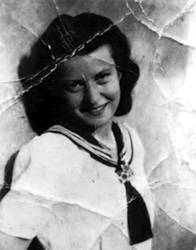
Halina Nelken ( September 1923 Krakow- March 2009 Boston) daughter of Emanuel and Regina Nelken
And Yet, I Am Here!
The powerful story of a young woman's journey through the Holocaust
HALINA NELKEN
When Germany invaded Poland in 1939, Halina Nelken was a precocious fifteen-year-old, living a middle-class life in Krakow. Like other girls her age, she recorded her personal observations and feelings in a diary. As conditions in Krakow deteriorated and her family was forced into the Jewish ghetto, she continued to write, eventually smuggling her diary out with a Catholic friend. This remarkable book tells the story of Nelken's experiences in the ghetto and later in eight Nazi concentration camps, including Plaszow, Auschwitz, and Ravensbröck. Her diary entries, written between 1938 and 1943, form the core of the volume and are supplemented by recollections written shortly after the war, and by later commentaries and explanatory notes which she added in the mid-1980s. Although there exist numerous published and unpublished memoirs by Holocaust survivors, Nelken's book presents one of the few extant diaries written at the time. Already released in Polish and German editions, it has been hailed as one of the finest works of its kind. Now it is available in English for the first time.
"While memoirs of the war years abound, diaries kept at the time are rare. Still rarer are diaries as moving, intelligent, and well-written as this one. The work of an independent, highly observant, and talented girl, it invites comparison to The Diary of Anne Frank and does not lose in the comparison. . . . Nelken's book is a brilliant and engrossing portrayal of the coming of age of a Polish Jewish girl during the Second World War, as well as an authentic, eyewitness account of life in all its moral complexity in German-held Krakow and the concentrations camps."—Alicia Nitecki, author of Recovered Land
"A priceless document of rare value and importance, which allows the reader and the historian of the period to comprehend more clearly the psychological plight of the people locked in the ghetto, through the personal experience and thorough self-analysis of a young girl."—Gideon Hausner, chief prosecutor,
Eichman trial, and author of Justice in Jerusalem
"Nelken's diary is one of the most important to survive from the Second World War. Written by a young girl from a protected and privileged background, it gives a unique and moving account of the Nazi occupation and of the experience of the camps of Plaszow and Auschwitz. . . . There are many memoirs and diaries of the Holocaust, but few with such immediacy and with such a genuine voice."—Antony Polonsky, Brandeis University
"As a teenager, Nelken, who is Jewish, kept a diary of the permanent destruction of her comfortable life when the Nazis overran her homeland. Unlike Anne Frank, this girl survived the Holocaust to tell the full story. Now an art historian, she was born to a prosperous, assimilated Polish family. And she recalls, with bittersweet verisimilitude, her idyllic early days in Krakowthe people and the pastry, the kitchens and the streets. Moved from home to the ghetto and to ever more confined quarters and constricted living conditions, Nelken goes on to describe the travails of her parents and brother, her friends at gimnazium (when she was allowed to attend school), her work (including enforced street cleaning), and, with special grace, her youthful yearnings and romances. Despite lack of rest and food, she notes the music, poetry, and aspirations she found in the ghetto. ``Somehow,'' she wrote in her diary, ``I hope that something will happen and my life will change for the better.'' Then the ghetto was closed, and Nelken, her mother, and sister-in-law were sent to the Plaszow, Auschwitz, and Ravensbrck concentration camps, where the likes of Amon Gth, Franz Hoessler, and Dr. Mengele were her keepers. By the closing days of the war, some prisoners were able to escape and, save for her father, the author and her immediate family endured. Her story of purgatory is a lifetime ago and a world away from her present life in academic Cambridge, Mass. But she fulfills a moral obligation to remember the past, while urging us not to heed the ``professional Holocaustniks'' who weren't even there. ``If only,'' she wishes for those who were, I could protect all of us from forgetfulness, individually, as we were, we living people!'' In moving testimony, her legacy is another story snatched from six million. An intelligent and writerly memoir."—Kirkus Reviews
After World War II, Halina Nelken pursued a career as an art historian, moving to the United States in 1959. She now lives in Cambridge, Massachusetts.
Foreword by George H. Williams . . . ix
Introduction by Gideon Hausner . . . xi
Prologue: 7 D?ugosza Street . . . 11
1 Diary from the Ghetto in Kraków . . . 372
2 Behind Barbed Wire: P?aszów, Auschwitz, Ravensbruck . . . 199
3 Bottomless Pit . . . 245
4 Return to Kraków . . . 267
Epilogue: The Legacy of the Holocaust . . . 271
Glossary . . . 275
Biographical Note . . . 277
Illustrations follow page 198
- See more at: http://www.umass.edu/umpress/title/and-yet-i-am-here#sthash.NtimZPFs.dpuf
survivor of eight camps Halina Nelken used to work in the Auschwitz office compiling the numbers gassed and falsifying the cause of death of murdered inmates in the camps records.
Two rows of file cabinets stood in the middle of the room, their deep drawers full of folders and index cards for all inmates in Auschwitz-Birkenau and the subcamps: Buna, Monowitz, and the others. Each one of us worked on different letters of the alphabet. According to daily reports we received from the Sclzreibstube , the camp clerk's office, we kept track of transfers from block to block, work assignments, and the deaths of inmates. Jewish transports from all over Europe went to the gas chambers with only general remarks from the administration of the crematorium: Verwaltung des Krematoriums gibt bekannt—on such and such a day, so many thousand from such and such a country were gassed in Birkenau. Just that—GASSED.
In case of the death of a registered inmate, regardless of the cause—beating, "selection," starvation, exhaustion—we wrote "heart attack" or "pneumonia" on the index card, removed it from the files, and placed it into the Totenkartei , the death register.
On my first day, I was told to straighten up these Totenkartei in the next room. Index cards tied with string were stacked up to the ceiling, but a pile of them from the last few months had fallen out and was lying in a disorderly heap. I began to arrange them on the shell when some writing in red pencil on one of the packages caught my eye: transport from P?aszów-Kraków vergast in May, along with the Hungarian transport. Gassed!
Shaking, I went through these index cards. He was there: Edmund Emanuel Nelken. My father.
I handled the daily reports from the Verwaltung des Krematoriums . There was always a long list of the names and tattoo numbers of gassed inmates. I remembered the flames blazing from the chimneys in Birkenau when I saw in what a frighteningly meticulous bookkeeping system the thousands of Auschwitz inmates were recorded, those of us still living or already on the Totenkartei . I did not believe that the Germans would allow even one witness to such documentation remain alive.
Halina Nelken, Alicia Nitecki (trans.), And Yet, I Am Here, Amherst: University of Mass. Press, 1999 (originally published in Polish as Pami?tnik z getta w Krakowiein , 1986), p.229.
NELKEN, Halina Of Cambridge. Entered into rest March 15, 2009, at the age of 85. Beloved mother of Les Nelken & his wife Helen Ronan of Acton, Cherished grandmother of Jason Nelken. Services at Stanetsky Memorial Chapel, 1668 Beacon Street, BROOKLINE on Friday, March 20, 2009 at 1:00 PM. Interment in Temple Emeth Memorial Park, West Roxbury. Memorial observance will be private. In lieu of flowers, expressions of sympathy in her memory may be donated to the USC Shoah Foundation Institute for Visual History and Education. A native of Krakow, Poland, born in 1923 to Emanuel and Regina Nelken, Mrs. Nelken was a holocaust survivor. A noted writer, lecturer and art historian, she was the author of "And Yet, I am Here!" Stanetsky Memorial Chapels Brookline (617) 232-9300
- See more at: http://www.legacy.com/obituaries/bostonglobe/obituary.aspx?pid=125262725#sthash.DsmOPAWD.dpuf
--
USC Shoah Foundation Institute testimony of Halina Nelken
Record Type:
Oral History
Interviewee:
Halina Nelken
Gender:
F
Birth Year:
1925
Birth City:
Cracow (Poland)
Birth Country:
Poland
Prewar Religious Identity:
Judaism
Ghettos:
Cracow (Poland : Ghetto)
Camps:
Malchow (Germany : Concentration Camp)
Auschwitz I (Poland : Concentration Camp)
Auschwitz II-Birkenau (Poland : Death Camp)
Ravensbrück (Germany : Concentration Camp)
Krakau-Plaszow (Poland : Concentration Camp)
Krakau (Poland : Concentration Camp)(generic)
Krakau (Poland : Concentration Camp)(generic)
Leipzig-Mansfeld (Germany: Concentration Camp)
Hiding or False Identity Location:
Nossen (Germany)
Location of Liberation:
Leipzig-Mansfeld (Germany: Concentration Camp)
Liberated By:
armed forces/ Soviet
Other Experiences:
escapes during forced marches
concealment of Jewish identity
Interview Date:
11/24/1995
Interview Location:
MA / U.S.A.
Interview Length:
4:21:40
VHA Interview Code:
6258
Experience Group:
Jewish Survivor
Description:
Forms part of the USC Shoah Foundation Institute Visual History Archive.
Restrictions:
On-site access only. Registration required.
Language:
English
Special Collection:
USC Shoah Foundation Visual History Archive
Holdings Status:
Testimonies cannot be viewed from USHMM Collections Search.
Locate a viewing station near you: (http://sfi.usc.edu/locator)
Obtain copies of interviews directly from the USC Shoah Foundation: (https://sfiaccess.usc.edu)
http://collections.ushmm.org/search/catalog/vha6258
alina Nelken was a Shoah survivor, who as a child lived in Podgorze district and an author of diaries from Krakow ghetto. We find her writings very powerful and unique for many reasons, firstly she draws a colorful and vivid picture of Podgorze from the pre war period secondly she gives an account of the atrocities of ghetto life in a very personal way. We are currently working on bigger commemorative project that would include a guided walking tour but also an audio tour. The work is still in research phase
|
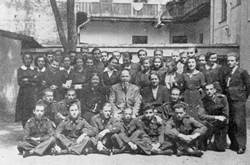
Klasa Haliny-gimnazjum Ko??a?taja 1939
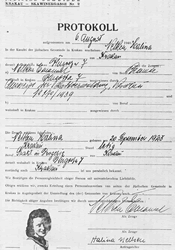
Protokoˇ? rejestracji w Gminie Z?ydowskiej
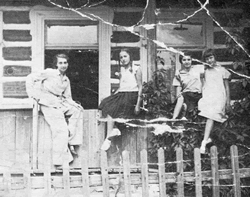
Rabka 1935-Halina po lewej
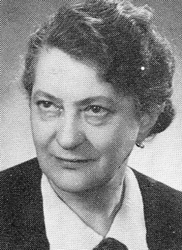
Regina Nelken po wojnie
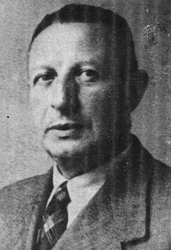
Tata Haliny-zdje?cie do Kennkarty 1941
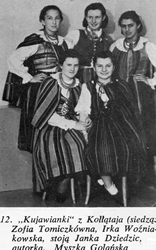
W szkole
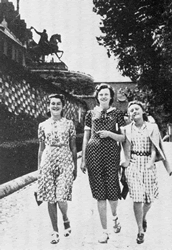
Wawel-2 dni przed wybuchem wojny
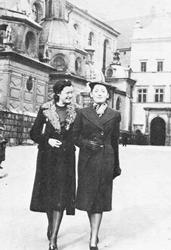
Wawel-marzec 1939

Zas┤wiadczenie by?ych wie?z┤niˇw Mauthausen |
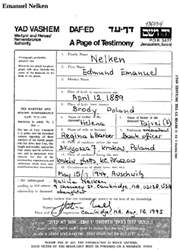
Halina gave reports to Yad Vashem about her parents who perished. Her father;
Emanuel Edmond Nelken
Birth:
1889
Brody, Brodivs'kyi district, Lviv Oblast, Ukraine
Death:
1944 (55)
Oswiecim, O?wi?cim County, Lesser Poland Voivodeship, Poland (Murdered by the Nazis)
Son of Favil Fabush Shraga Nelken and Helena Nelken
Husband of Regina Nelken
Father of Halina Nelken
Emanuel Nelken was born in Brody, Poland in 1889 to Fajvel and Helena. He was a bookeeper and married to Regina. Prior to WWII he lived in Krakow, Poland. During the war he was in Krakow, Poland.
Emanuel was murdered in the Shoah.
This information is based on a Page of Testimony (displayed here) submitted by his daughter: Halina Nelken
https://www.geni.com/photo/ view/6000000040049978518? album_type=photos_of_me&photo_ id=6000000040050005789 |
found some information about the brother who used another last name ; Feliks Gwozdz was born on November 22, 1920, in Kraków, Malopolskie, Poland, the son of Irene and Emanuel Nelken. He had children with Eugenia Gwozdz. He died on July 24, 1979, in Fort Worth, Texas, at the age of 58, and was buried there.
Felix had the wife of Gienia (Eugenia). it changed.
Probably the Feliks Gwó?d? is the same Felix. Only his mother's name does not match, but maybe she used another one later.
I found confirmation of this. Article:
http://www.valdostadailytimes. com/news/local_news/eugenia-s- story/article_44ba1b7f-a084- 5309-b09d-d304f85a4dae.html
Eugenia’s Story
Dean Poling
The Valdosta Daily Times Nov 8, 2012
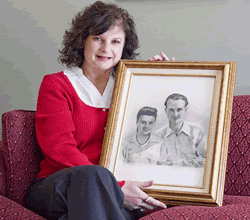
Donna Farwell of Valdosta poses with a portrait of her parents, Eugenia and Feliks Gwozdz, after they survived the Holocaust and prepared to move to the United States.
s
http://www.valdostadailytimes. com/news/local_news/eugenia-s- story/article_44ba1b7f-a084- 5309-b09d-d304f85a4dae.html
As a child, Donna Farwell knew her parents had been held in a Nazi concentration camp. The evidence of her mother surviving the Holocaust was as simple as looking at the registration number tattooed on the inside of her mother’s forearm: A26460.
But Donna Farwell didn’t know until near her adulthood that her parents were Jewish.
“My parents were Catholic,” Farwell says. “I thought they were political prisoners from Poland in the concentration camps.”
It wasn’t until the early 1980s, about three years after her father passed away, when Farwell learned of her family’s Jewish heritage.
In 1951, wanting to move to the United States, worried they would be denied a visa, worried their children may one day face a second Holocaust, Feliks and Eugenia Gwozdz converted from Judaism to Catholicism.
Stateside, the couple raised five children. Donna is the youngest. They settled in Texas. They didn’t just join the Catholic church there. The Gwozdz family became deeply involved in the church and its music programs, a trait shared by their youngest daughter.
Donna Farwell has served 16 years as the youth choir director at St. John’s Catholic Church in Valdosta; she has also worked for eight years as a personal banker with Bank of America. Married to Doug Farwell, who is Valdosta State University Music Department interim head, Valdosta Symphony Orchestra executive director, and a music professor of trombone, they have two daughters, Donica, a Valdosta High School junior, and Darcy, a St. John’s Catholic School eighth grader.
Recently, Donna Farwell shared her parents’ story with Dr. Louis Schmier’s VSU Holocaust class. Her presentation included an abridged taped interview for the Shoah Foundation. In the tape, Eugenia Gwozdz shares her experiences in pre-war Poland, in the concentration camps, and the move to the United States.
Feliks was born in 1920. Eugenia was born in 1924. She came from a prosperous family that manufactured furniture. Growing up, Eugenia lived with her parents, grandmother, and two younger siblings; none of them would survive the Holocaust.
Feliks attended school at Poland’s University of Krakow. One of his classmates was Karol Josef Wojtyla, the man who would become Pope John Paul II.
Eugenia met Feliks. They fell in love. Though she was young, they married in 1939 in the ghetto. As the Nazis invaded Poland and rounded up the Jews, their honeymoon became a nightmare.
Decades later, Eugenia would recall the screams of her beloved grandmother as the Nazis dragged her away. Eugenia never again saw the family of her childhood. With exception of a few photos she managed to preserve through the years and her memories, Eugenia’s childhood family vanished.
Separated from her husband, she was processed into a concentration camp with her mother-in-law and sister-in-law.
“We didn’t know where we was going but we knew of the gas chambers,” Eugenia said in the taped oral history of how the Nazis killed hundreds of thousands of Jews. She continued the remark referring to Holocaust deniers. “Of course, some people don’t believe that. Of course, then, we didn’t believe that.”
Eugenia recalls all of the women being forced to strip naked but being allowed to keep their shoes. Her shoes were a rugged pair of ski boots, which she wore until war’s end.
She survived and was able to keep her boots, a few family photos and a small, heart-shaped trinket from Feliks because a Nazi guard fell in love with her sister-in-law.
Her jobs in the concentration camps included transporting rubber to factories and transporting dead bodies. Though protected by the Nazi guard, Eugenia and her in-laws endured many hardships. They never knew when they would be called to witness a fellow prisoner’s execution, which could be a man, woman or child.
“Every execution you have to witness because this is an event,” she said of their forced attendance. She recalled two young girls being executed. The Nazis told the gathered prisoners that the children had abetted a thwarted uprising. They were tiny little girls, Eugenia said. Soldiers and police dogs surrounded the girls as they were led to their deaths. Contrasting the brutal security with the frailty of the children, Eugenia asked in her taped interview, “Where were they going to go?”
Some prisoners committed suicide on the electrical wire surrounding the camps. People faced losing body parts or being poisoned through various injections as part of Nazi experiments.
Soup was mostly water, but some prisoners would hoard or steal what small amount of soup they received to sell to other prisoners. Nazis forced prisoners to march to classical orchestra music broadcast through loud speakers.
Near war’s end, Donna Farwell shares that her mother, aunt and grandmother were being marched to another location. Eugenia and her in-laws used the move as an opportunity to escape. Guards fired at them. One bullet, according to family lore, struck the heel of one of Eugenia’s ski boots protecting her foot from injury.
With the Allied invasion approaching, the guards made no real effort to pursue them. Eugenia was free but had no idea where Feliks might be. As the Nazi regime collapsed, the war ended and the concentration camps liberated, Eugenia searched for Feliks. Every day, she walked to the train station, searching the faces of people for hours, looking for a glimpse of Feliks.
One day, she noticed the person sitting next to her reading a letter. Eugenia’s eyes moved to the handwriting. Remarkably, she realized the handwriting was not only familiar but that of her husband. The man next to her confirmed that Feliks had written the letter. Feliks was in Munich looking for Eugenia. They were soon reunited in Munich.
“It was like heaven on earth,” Eugenia said of the reunion.
The number from Auschwitz is right. The 3 were there in : Halina, Regina and Eugenia and they had consecutive numbers. Halina had A-26462.
It seems to me that Feliks married Gnia in 1941 or 1942, not in 1939. He had met with Fela before.
Do you have the opportunity to read Halina's book? This is her diary. You can learn a lot about the whole family.
Liliana |
| |
| |
|
|
|